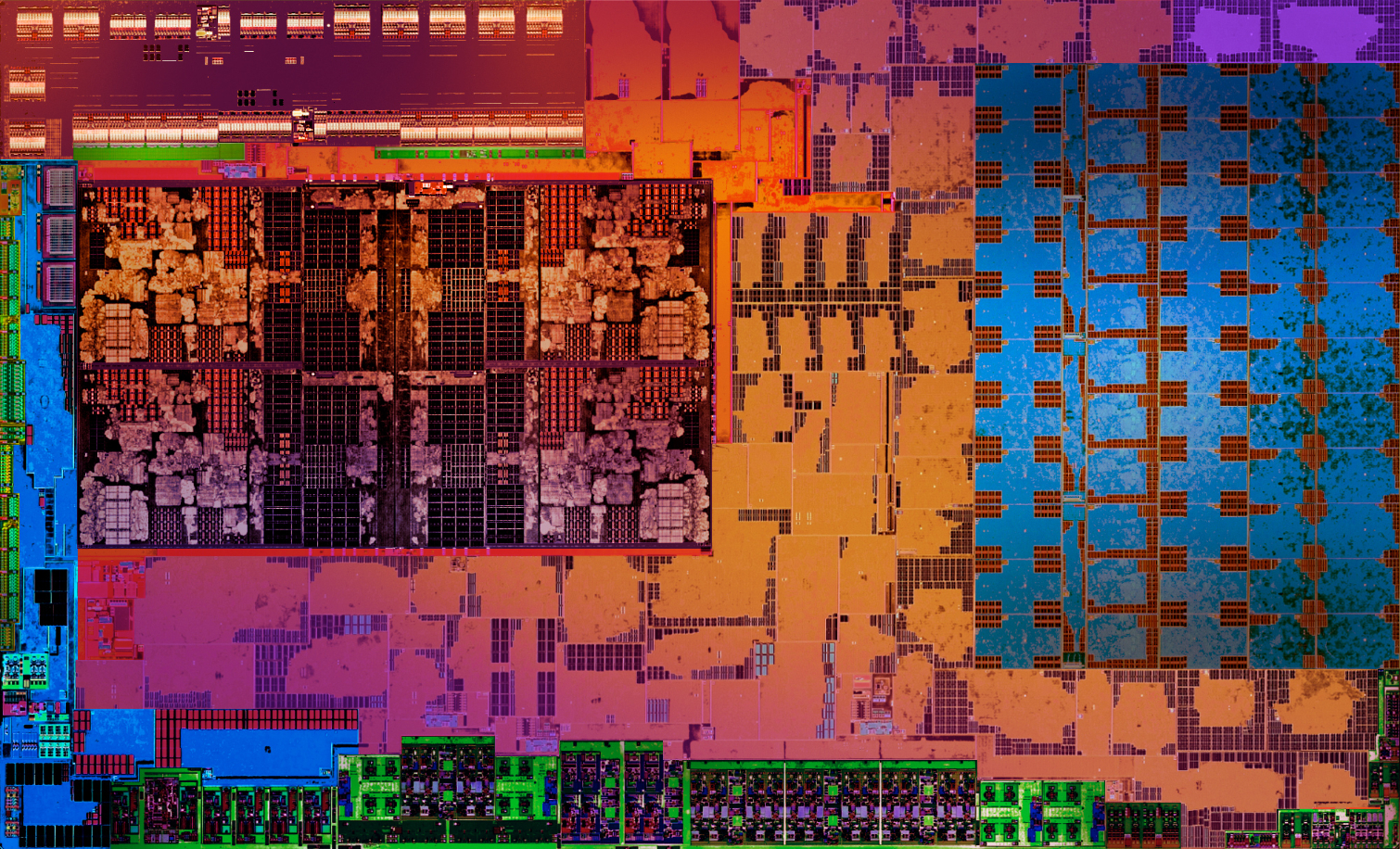AMD Ryzen 5 2400G Review: Zen, Meet Vega
Why you can trust Tom's Hardware
Zen, Meet Vega
If you missed our coverage of the Zen design, check out Everything Zen: AMD Presents New Microarchitecture At HotChips. We're not going that deep in today's review. But to better understand how the Raven Ridge die operates, we have to take a quick look at the Zeppelin silicon that made Ryzen famous.
The Zen microarchitecture centers on a four-core CCX building block. AMD complements each CCX with an 8MB L3 cache split into four slices. Two CCXes (we outlined one in green) come together to create an eight-core Zeppelin die. All Ryzen desktop processors, until now, featured the same underlying design, regardless of the number of active cores.
CCXes communicate with each other via AMD’s Infinity Fabric, which is an optimized version of HyperTransport, and share memory controllers over the bus. This is basically two quad-core CPUs talking to each other over an on-die interconnect that also handles northbridge and PCIe traffic.
Raven Ridge essentially replaces the second CCX with a graphics engine. Now, the die is divided up into one CCX, Vega Graphics, and the uncore. The uncore includes an Infinity Controller, the Infinity Fabric, and the I/O and System Hub. Whereas Zeppelin is composed of 4.8 billion transistors across 213mm2, the Raven Ridge die below has 4.94 billion transistors and measures 209.8mm2.
Unlike previous Ryzen products, all four execution cores reside in a single CCX (orange block to the left in the image above). That means an application running on multiple cores does not have to traverse the Infinity Fabric to communicate with other cores and cache. We know from past tests that working across the Infinity Fabric with a set of “remote” cores (and cache) can negatively affect performance in latency-sensitive applications, such as games. Raven Ridge’s single CCX should fare better in those situations.
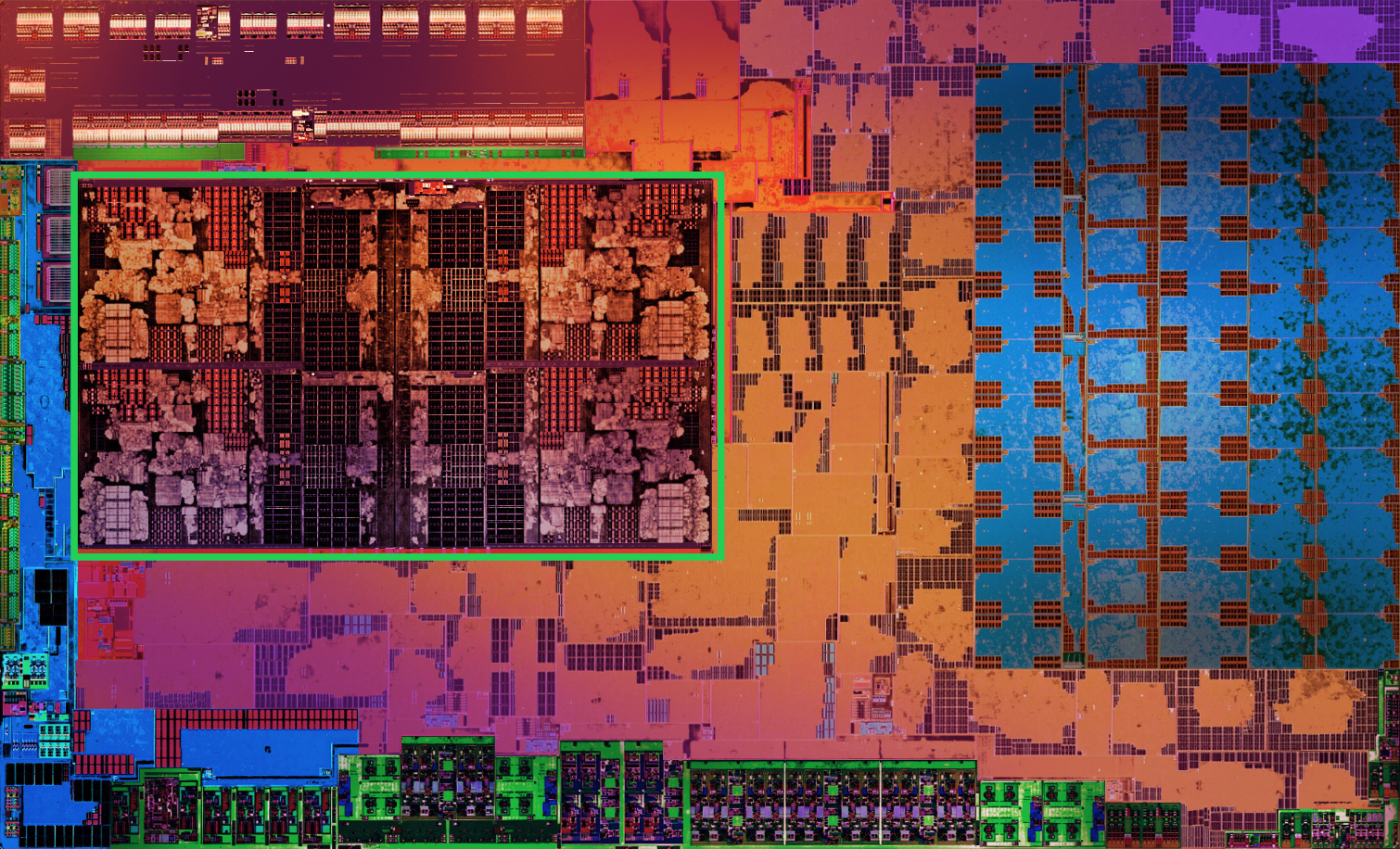
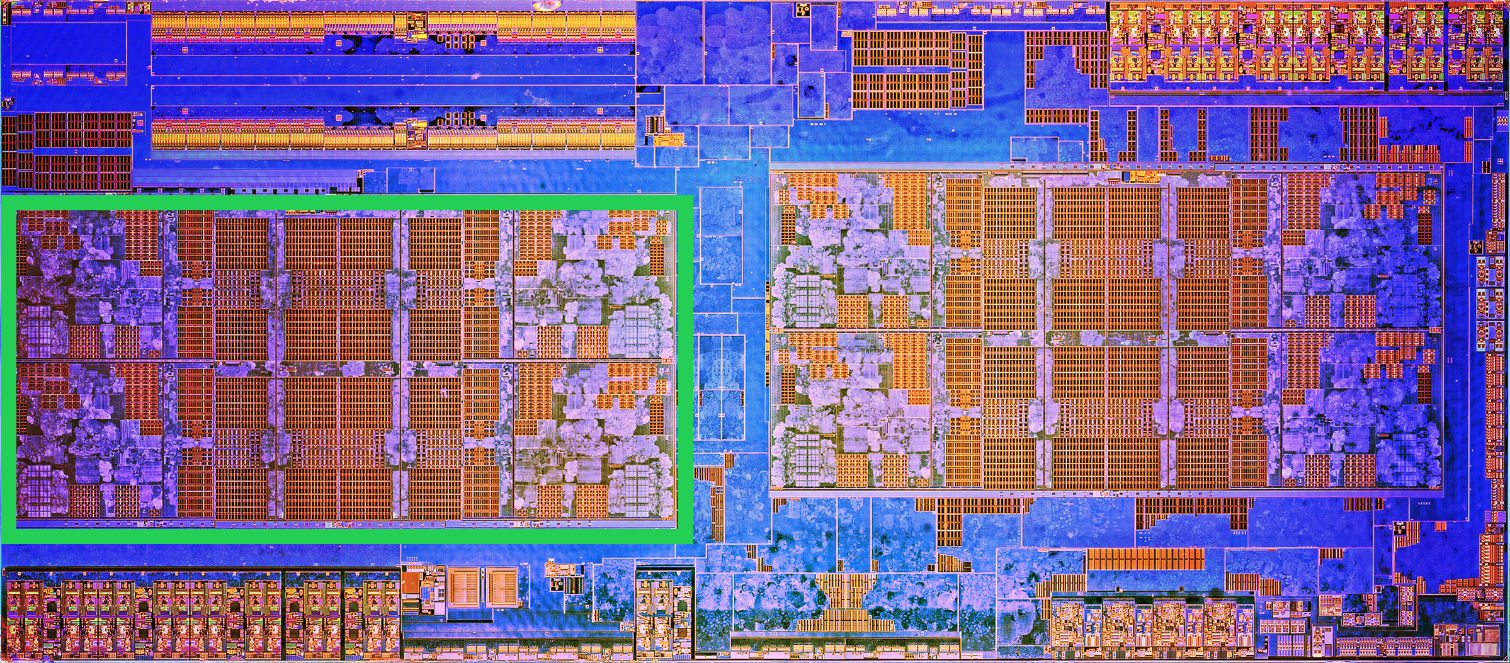
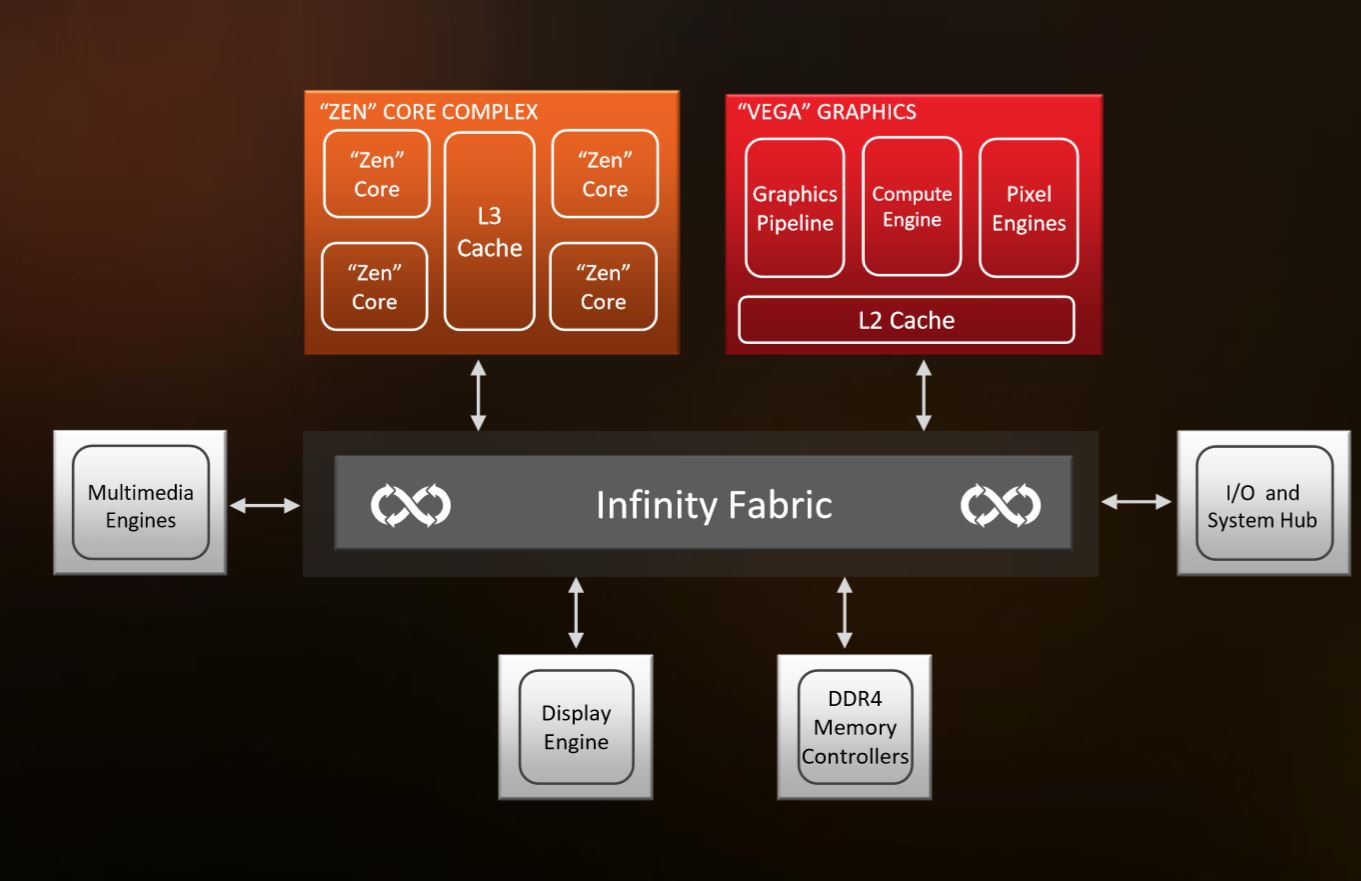
We outlined the four-core CCXes with green boxes. Similar to what you've seen from AMD's Zeppelin die, the center of a Raven Ridge CCX contains vertical rows of L3 cache. Of course, a Zeppelin CCX has four rows of L3 cache units in the center, which add up to 8MB. The Raven Ridge CCX only sports two rows, giving us 4MB. That means Raven Ridge's L3 capacity isn't an arbitrary restriction or the product of market segmentation. Rather, it was an architectural design choice.
The orange block in the upper-left corner of Raven Ridge contains the interconnect circuitry and control units. That's in the same place on Zeppelin. But the DDR4 memory controllers and platform I/O circuitry around the edges move to different locations. Work definitely went into getting this die's layout just right, and even though the cores themselves appear identical, the CCX design is new.
Get Tom's Hardware's best news and in-depth reviews, straight to your inbox.
Raven Ridge processors use Infinity Fabric to connect the CPU cores and on-die Vega CUs (the blue block on the right). But the fabric is merely a protocol. That means it can travel through a number of physical connections, such as interposers, PCB traces, or internal PCIe lanes. One could guess that the protocol operates over an internal PCIe bus, and that the graphics engine consumes some available connectivity, thus trimming Raven Ridge's externally-accessible lanes down to eight. It's also possible that the drop from 16 to eight lanes was another design choice, just like less L3 cache.
As we've demonstrated, increasing the system's memory frequency also improves Infinity Fabric throughput, speeding transfers between the execution cores and CUs. And of course, the Vega-based graphics engine stands to benefit greatly from more memory bandwidth, so you'll want to crank up DDR4 frequencies up as much as possible for better performance.
Unfortunately, we can't yet measure Infinity Fabric latency improvements with existing tools, though we're working on ways around that. In the meantime, we ran some benchmarks on the new cache hierarchy. Despite Ryzen 5 2400G's lower cache capacity, we are expecting speed-ups attributable to design tweaks.
| Row 0 - Cell 0 | L1 | L2 | L3 | Main Memory |
| Range | 2KB - 32KB | 32KB - 512KB | 512KB - 8MB | 8MB - 1GB |


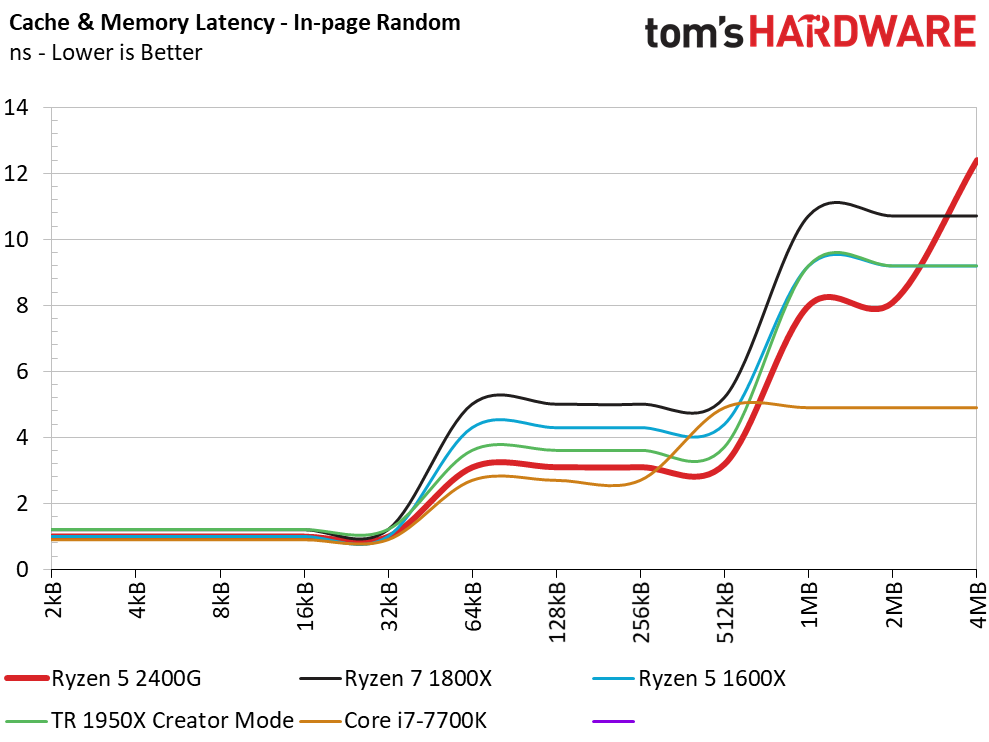
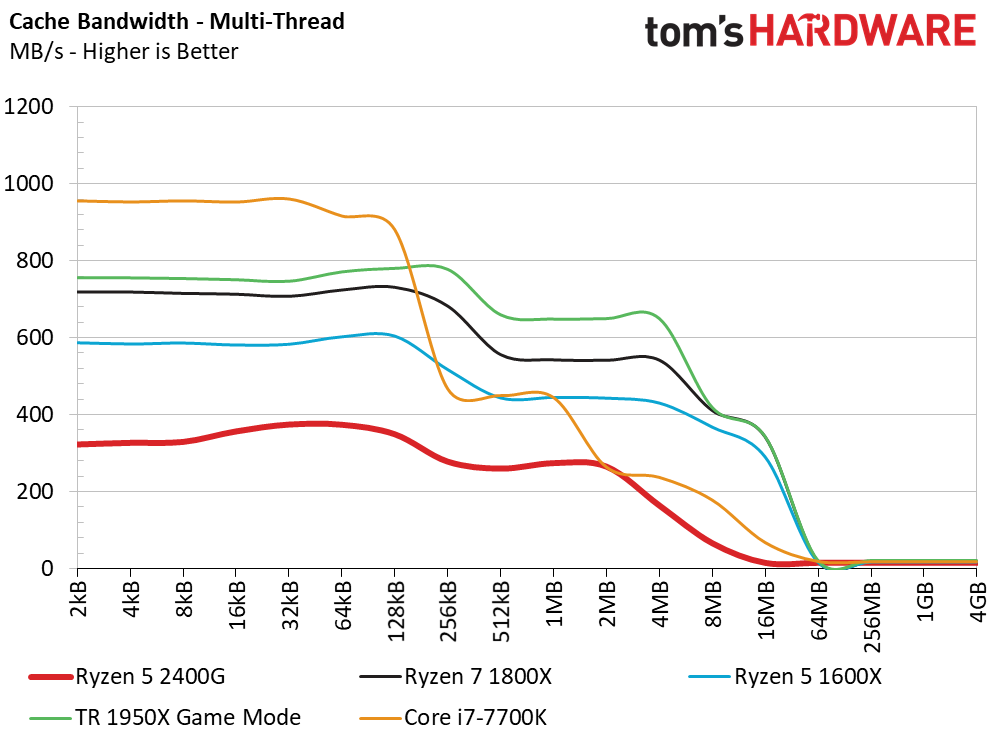
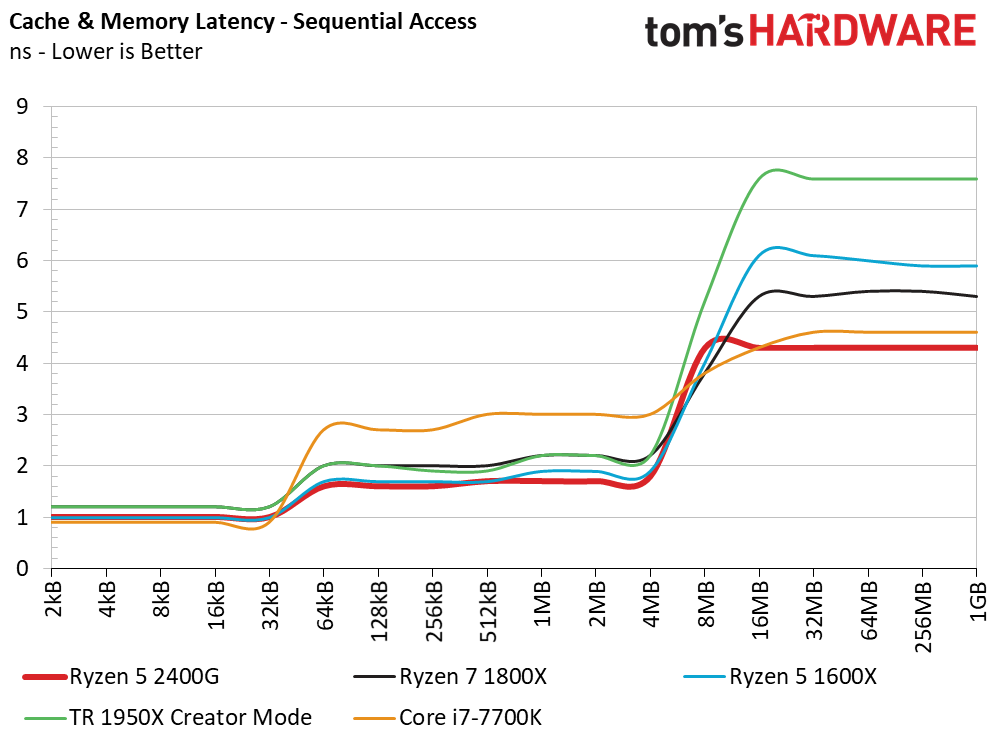
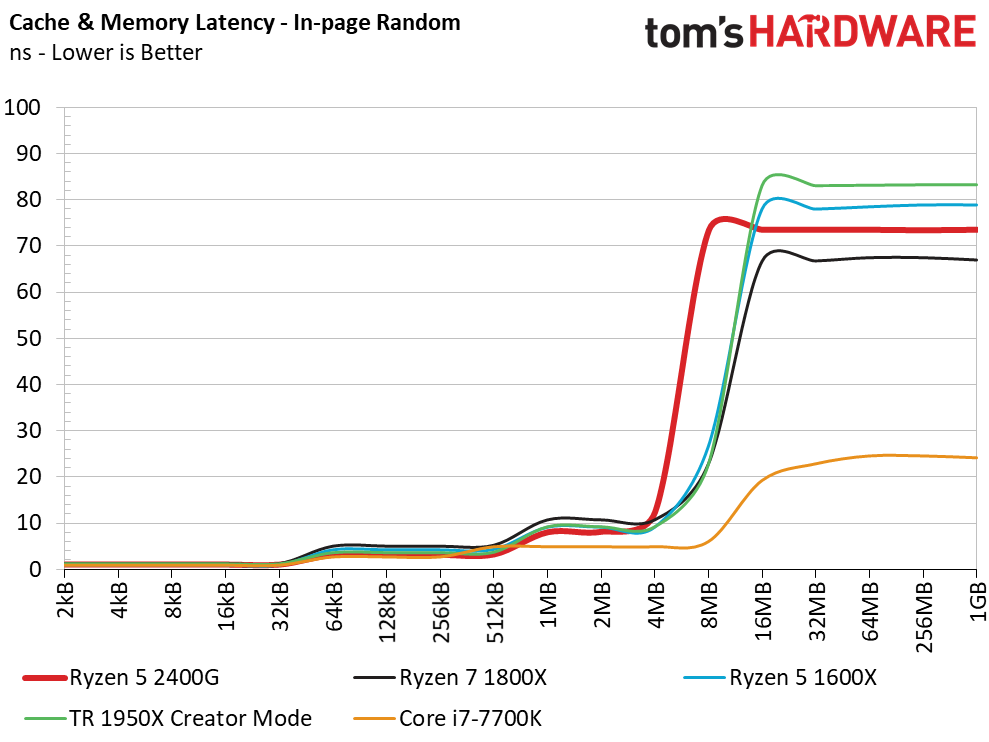
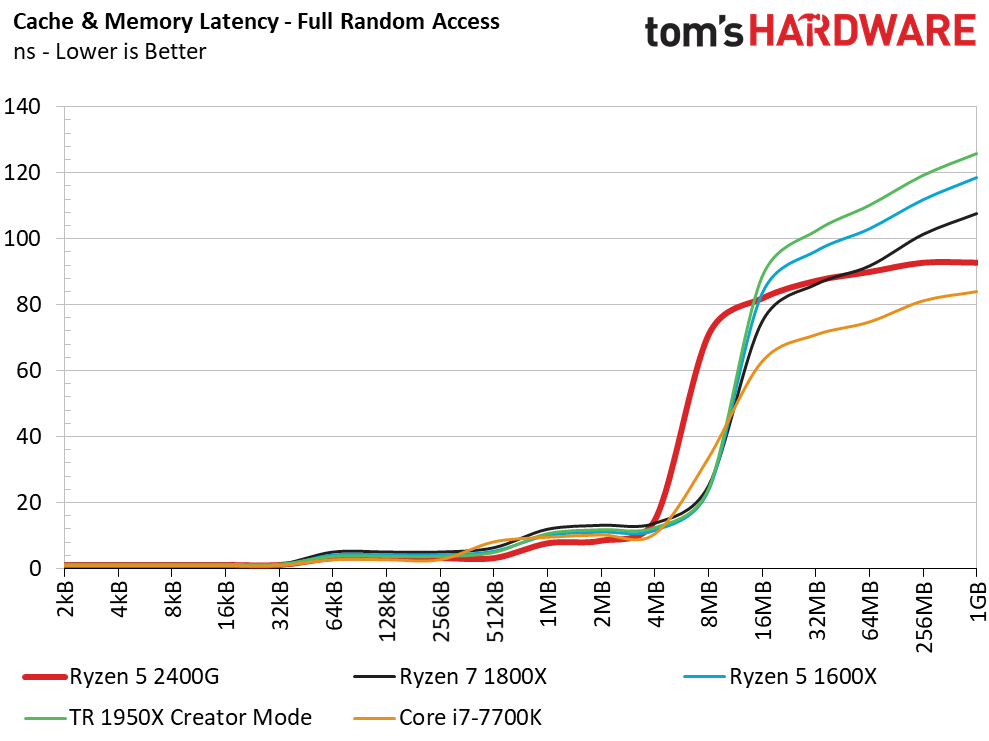

From a high level, Ryzen 5 2400G's single-threaded cache throughput remains comparable with the previous-gen Ryzen. But multi-threaded throughput declines significantly due to fewer responding regions.
As a result of the new single-CCX design and other tweaks, we observe the lowest L2 and L3 cache latency seen from a Ryzen CPU. That's a good omen of what we might see from latency-sensitive applications. This trend holds true for all three types of data access, which we've explained in-depth. We also provide zoomed-out versions of the latency measurements that show main memory latency. The 2400G excels in the sequential and full random access tests to main memory.
MORE: Best CPUs
MORE: Intel & AMD Processor Hierarchy
MORE: All CPUs Content
Current page: The Raven Ridge Die
Prev Page The Fusion Of Zen & Vega Next Page 14nm+, Precision Boost 2 & Power Management
Paul Alcorn is the Editor-in-Chief for Tom's Hardware US. He also writes news and reviews on CPUs, storage, and enterprise hardware.
-
InvalidError Looking at Zeppelin and Raven dies side by side, proportionally, Raven seems to be spending a whole lot more die area on glue logic than Zeppelin did. Since the IGP takes the place of the second CCX, I seriously doubt its presence has anything to do with the removal of 8x PCIe lanes. Since PCIe x8 vs x16 still makes very little difference on modern GPUs where you're CPU-bound long before PCIe bandwidth becomes a significant concern, AMD likely figured that nearly nobody is going to pair a sufficiently powerful GPU with a 2200G/2400G for PCIe x8 to matter.Reply -
Olle P 1. Why did you use 32GB RAM for the Coffee Lake CPUs instead of the very same RAM used for the other CPUs?Reply
2. In the memory access tests I feel to see the relevance of comparing to higher teer Ryzen/ThreadRipper. Would rather see comparison to the four core Ryzens.
3. Why not also test overclocking with the Stealth cooler? (Works okay for Ryzen 3!)
4. Your comments about Coffee Lake on the last page:
"Their locked multipliers ... hurt their value proposition...
... a half-hearted attempt to court power users with an unlocked K-series Core i3, ... it requires a Z-series chipset..."As of right now all Coffee Lake CPUs require a Z-series chipset, so that's not an added cost for overclocking. I'd say a locked multiplier combined with the demand for a costly motherboard is even worse. (This is suppsed to change soon though.) -
AgentLozen Tom's must think highly of this APU to give it the Editor's Choice award. It seems to be your best bet for an extremely limited budget.Reply
I totally understand if you only have a few hundred dollars to build your PC with and you desperately want to get in on some master race action. That's the situation where the 2400G shines brightest. But the benchmarks show that games typically don't run well on this chip. They DO work under the right circumstances, but GTAV isn't as fun to play at low settings.
Buying a pre-built PC from a boutique with a GeForce 1050Ti in it will make your experience noticeably better if you can swing the price. -
akamateau What most writers and critics of integrated graphics processors such as AMD's APU or Intel iGP all seem to forget, is not EVERYONE in the world has a disposable or discretionary income equal to that of the United States, Europe, Japan etc. Not everyone can afford bleeding edge gaming PC's or laptops. Food, housing and clothing must come first for 80% of the population of the world.Reply
An APU can grant anyone who can afford at least a decent basic APU the enjoyment of playing most computer games. The visual quality of these games may not be up to the arrogantly high standards of most western gamers, but then again these same folks who are happy to have an APU also can not barely afford a 750p crt monitor much less a 4k flat screen.
This simple idea is huge not only for the laptop and pc market but especially game developers who can only expect to see an expansion of their Total Addressable Market. And that is good for everybody as broader markets help reduce the cost of development.
This in fact was the whole point behind AMD's release of Mantle and Microsoft and The Kronos Group's release of DX12 and Vulkan respectively.
Today's AMD APU has all of the power of a GPU Add In Board of not more than a several years back. -
Blas "Meanwhile, every AMD CPU is overclockable on every Socket AM4-equipped motherboard" (in the last page)Reply
That is not correct, afaik, not for A320 chipsets. It is for B350 and X370, though. -
salgado18 "with a GeForce 1050Ti in it will make your experience noticeably better if you can swing the price."Reply
"a card is still needed"
You do realize that these CPUs have an integrated graphics chip as strong as a GT 1030, right? And that you are comparing a ~$90 GPU to a ~$220 GPU?
If you can swing the price, grab a GTX 1080ti already, and let us mITX/poor/HTPC builders enjoy Witcher 3 in 1080p for a fraction of the price ;) -
InvalidError Reply
When 1080p displays are available for as little as $80, there isn't much point in talking about 720p displays. I'm not even sure I can still buy one of those even if I wanted to unless I shopped used. (But then I could also shop for used 1080p displays and likely find one for less than $50.)20700012 said:but then again these same folks who are happy to have an APU also can not barely afford a 750p crt monitor much less a 4k flat screen.
The price of 4k TVs is coming down nicely, I periodically see some 40+" models with HDR listed for as little as $300, cheaper than most monitors beyond 1080p.
Depends for who, not everyone is hell-bent on playing everything at 4k Ultra 120fps 0.1% lows. Once the early firmware/driver bugs get sorted out, it'll be good enough for people who aren't interested in shelling out ~$200 for a 1050/1050Ti alone or $300+ for anything beyond that. If your CPU+GPU budget is only $200, that only buys you a $100 CPU and GT1030 which is worse than Vega 11 stock.20700022 said:Graphics still too weak , a card is still needed.
If my current PC had a catastrophic failure and I had to rebuild in a pinch, I'd probably go with the 2400G instead of paying a grossly inflated price for a 1050 or better. -
Istarion People come here expecting to find an overclockeable 4 core with a 1080-like performance for 160$. And a good cooler. I'd love to be so optimistic :DReply
Summarizing: we are saving around 50-100$ for the same low-end performance. That's 25% to 40% cheaper. What are we complaining about?!? I'd be partying right now if that happened in high-end too!!! 300$ for a 1080...
All those comments saying "too weak", or "isn't fun to play at low settings", seriously, travel around the globe or just open your mind, there's poor people in 90% of the world, do you think they'll buy a frakking 1080 and a 8700k?!?
And there's even non-poor people that doesn't care about good graphics! Go figure!
Otherwise, why there are pixel graphics games all over the place? Or unoptimized/breaking early access games??
I have a high-end pc and still lower fps to minimum for competitive play, so I won't see any difference between a 1080Ti vs a 1070 (250 vs 170fps, who's gonna see that, my cat?!? No 'cause my monitor is not fast enough!). -
rush21hit As a cyber cafe owner, I would love to replace my old A5400s to the lower R3.Reply
Except that the DDR4 sticks went crazy expensive over here. FML
